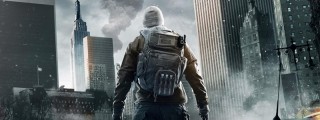I’ve been starry eyed with The Division for a long time. From the game’s earliest trailers, I’ve been captivated with what I always considered one of the most compelling aesthetics of this current generation of gaming. A New York buried under the snow and trapped as a Christmas time capsule, where every day New Yorkers had been converted into soldiers engaged in a bitter war for the city’s soul. Art books are always a great chance to get a glimpse at the initial gears behind a game’s final working parts, and The Division’s strong sense of style is captivating even from its earliest seeds.

Foremost the Division is a game about people. About you, a lone Division agent off to defeat a rogues gallery of faction leaders who all harbor destructive behavior threatening to rip the Island apart. It’s about the survivors and the infected, destitute and scrounging the streets of New York city. The first responders left behind in the wake of the chaos, and the average janes and joes just trying to get by. It’s appropriate than that the art books dedicates large amounts of time to The Division’s cast of characters and various factions. Several glossy, full color pages that give a nice little glance into the decision making process behind each character. From the fierce Cleaners, fire toting maniacs who believe they can purge the virus with flame, to the intimidating Rikers who merge a police aesthetic with one of prisoners.

There are a lot of pages dedicated to The Division agent, the avatar the player creates to venture through the holiday ruins of New York. The book provides insights as to how Division Agents went through various phases, from plain clothes to militarized to pure science fiction, before finally settling on the look that perfectly merges civilian with armed forces. This is something I appreciated quite a bit about the book, because I find most art books fail to dedicate any kind of real look into the process of crafting their main characters. You would think it’s something the authors and editors of these books would spend a lot more time on, and something the artists would want to show off. I can, and have, glossed over these pages of Division agent sketches and paintings time and again.
The book also quite significantly grants a good, solid look into the various environments that make up The Division. I could, and have, gush endlessly about how this is the best recreation New York City I have ever seen in a video game. The environmental paintings located in this publication capture the magic just as much as the game has. Seriously, I’ve had flashbacks to times I’ve spent with my friends and family at the city’s various landmarks just taking in the art this book has to offer.

It’s not all grand however. If there’s one minor annoyance that turned into a bit of a major gripe with this book, it’s the utter overuse of the word “Iconic.” Anyone familiar with Ubisoft and their Ubi-isms will know this is a general problem with the company in general, all of their games, DLC, merchandise just telling you how “iconic” everything is. From “iconic” hats found in Watch Dogs to the “iconic” robes located in Assassin’s Creed. It loses all meaning when the company itself deems their work iconic, that’s really something for society and culture at large to decide, and it’s long sense been associated as a mere Ubisoft buzzword for the sake of advertising and forcing an identity. Here’s the issue, I already own the book, I’ve already purchased the game, I don’t need to be marketed at in the content I already own. Additionally the word is reprinted so many times in the book it began to lose all meaning. You could seriously play a drinking game with cans of Blue Ribbon, “Take a shot each time the word Iconic repeats” and get utterly trashed doing so.
Some of the information in the book seems to be, well, a tad outdated. For example, there’s a decent section towards the back dedicated to graffiti indicating how important it is to New York City. That might have been true a decade and a half ago, but land development and real estate had a say about that. The slight inaccuracies aside, it is overall a very thrilling book, and that section of the book in particular? Well Ubisoft commissioned some big time names in the graffiti scene to draft the pieces in game. Artists like Fab 5 Freddy and Futura 2000. I am a graffiti nut, I love the art myself, and do enjoy taking it in at the few bastions in New York left for it, so this was both a surprise and a real treat.

Ultimately, while I’m not sure as to how iconic it is, this is one of the better art books I’ve ever gotten my mitts on. I loved all 190 pages of it, and it gave a really detailed look as to how all the various smaller set pieces of The Division worked towards the greater whole. It’s not something I can say about each art book I own. Sometimes they might be good for a few character insights, but not much else, there was even one art book that dedicated most of its page count to loot acquired in game and I felt as though that were a bit of a rip off. The Division is definitely one of the most worthy art books I’ve ever had the privilege of adding to my collection.




